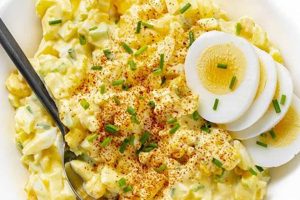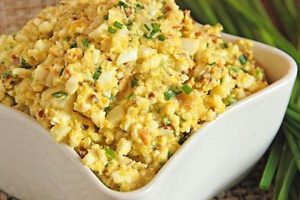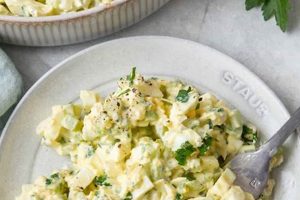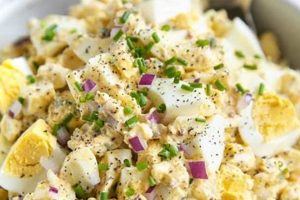A plant-based alternative to traditional egg salad, this dish utilizes crumbled tofu as the base, mimicking the texture and appearance of chopped eggs. Typical recipes incorporate vegan mayonnaise, mustard, celery, onion, and various seasonings to achieve a flavor profile reminiscent of the classic dish. Nutritional yeast is often included to impart a slightly cheesy, savory note and boost the nutritional value.
This culinary creation offers a compelling option for individuals seeking to reduce their consumption of animal products, whether for ethical, environmental, or health reasons. It provides a good source of plant-based protein and fiber, while remaining cholesterol-free. The adaptability of tofu allows for a wide range of flavor variations, catering to diverse palates and dietary needs. Its emergence reflects a broader trend towards innovative plant-based cuisine, addressing growing consumer demand for sustainable and compassionate food choices.
The following sections will delve deeper into ingredient selection, preparation techniques, nutritional information, and creative variations for this versatile dish.
Tips for Crafting Exceptional Tofu Egg Salad
Achieving an optimal texture and flavor profile requires attention to detail throughout the preparation process. These tips offer guidance for creating a superior tofu egg salad.
Tip 1: Press the tofu thoroughly. Excess water in the tofu will result in a watery final product. Pressing removes this excess moisture, allowing the tofu to absorb the flavors of the other ingredients more effectively.
Tip 2: Crumble the tofu to the desired consistency. For a closer approximation of traditional egg salad, aim for small, even crumbles. Larger pieces can be used for a chunkier texture.
Tip 3: Select a high-quality vegan mayonnaise. The mayonnaise serves as the foundation of the sauce, impacting both flavor and texture. Experimentation with different brands may be necessary to find a preferred option.
Tip 4: Don’t overlook the importance of seasonings. Black salt, also known as kala namak, can impart a subtle eggy flavor. Nutritional yeast contributes a cheesy, savory note. Adjust seasonings to personal preference.
Tip 5: Incorporate finely chopped vegetables for added texture and flavor. Celery and red onion are classic choices, but other vegetables like bell peppers or chopped pickles can offer interesting variations.
Tip 6: Allow the mixture to chill before serving. Chilling allows the flavors to meld and the texture to firm up, resulting in a more cohesive and flavorful salad.
Tip 7: Consider adding a touch of turmeric for color and a subtle earthy flavor. A small amount can enhance the visual appeal of the salad without overpowering other flavors.
By following these guidelines, one can create a delicious and satisfying tofu egg salad that rivals its traditional counterpart. These techniques ensure a well-balanced flavor profile and desirable texture.
This comprehensive approach to preparation allows for a truly enjoyable culinary experience, showcasing the versatility and potential of plant-based cuisine.
1. Tofu Preparation (Pressing, Crumbling)
Tofu preparation is paramount to a successful tofu egg salad recipe. Its porous nature necessitates pressing to remove excess water. Failure to do so results in a watery, diluted final product, compromising texture and flavor absorption. Pressing allows the tofu to effectively absorb the mayonnaise, seasonings, and other ingredients, creating a cohesive and flavorful mixture. Crumbling, subsequent to pressing, dictates the final texture. Fine crumbles mimic traditional egg salad, while larger pieces yield a chunkier texture. This control allows for customization based on individual preferences.
Consider the impact of insufficient pressing. A watery tofu base dilutes the vegan mayonnaise, hindering its ability to bind the ingredients and develop a rich, creamy texture. The flavors of seasonings and added vegetables become muted, resulting in a bland and unappetizing salad. Conversely, properly pressed tofu provides a neutral canvas, readily absorbing flavors and contributing to a robust, well-balanced final product. Similarly, the choice between fine crumbles and larger pieces affects the overall sensory experience. Fine crumbles create a smooth, spreadable consistency, while larger pieces provide a more substantial bite.
Effective tofu preparation, therefore, is not merely a preliminary step but a crucial determinant of the final dish’s quality. It directly influences texture, flavor absorption, and overall palatability. Mastering these techniques ensures a satisfying and successful tofu egg salad experience, demonstrating the significant impact of proper ingredient preparation on the final outcome. This attention to detail elevates the dish from a simple substitute to a culinary creation in its own right.
2. Vegan Mayonnaise Selection
Vegan mayonnaise selection is a critical determinant of flavor and texture in tofu egg salad. The right choice elevates the dish, while a subpar selection can compromise the overall experience. Careful consideration of available options is essential for achieving desired results. This section explores the nuances of vegan mayonnaise selection and its impact on the final product.
- Flavor Profile
Vegan mayonnaise options exhibit diverse flavor profiles. Some emphasize tanginess, while others prioritize richness or neutrality. A neutral-flavored mayonnaise allows other ingredients, such as seasonings and vegetables, to shine. Conversely, a bolder mayonnaise contributes a distinct flavor element. For example, a lemon-infused vegan mayonnaise adds brightness, while a garlic aioli-style mayonnaise imparts a savory richness. Selecting a flavor profile that complements the other ingredients ensures a balanced and harmonious final dish.
- Texture and Consistency
Texture and consistency vary significantly across vegan mayonnaise brands. Some are thick and creamy, ideal for binding the tofu crumbles and creating a rich mouthfeel. Others are thinner and more fluid, potentially resulting in a runnier salad. The desired consistency depends on personal preference. A thicker mayonnaise emulates traditional egg salad more closely, while a thinner mayonnaise offers a lighter texture. Evaluating consistency is crucial for achieving the desired final product.
- Ingredient Composition
Ingredient composition impacts not only flavor and texture but also nutritional value and potential allergen considerations. Some vegan mayonnaises rely on soy-based ingredients, while others utilize oils like sunflower or canola. Individuals with soy allergies must carefully examine ingredient lists. Additionally, some brands prioritize whole-food ingredients, while others incorporate processed components. Understanding ingredient composition allows for informed choices aligned with dietary needs and preferences. This awareness ensures the selection of a mayonnaise that complements both the recipe and individual health goals.
- Oil Content
Oil content significantly influences the richness and mouthfeel of the tofu egg salad. Higher oil content typically results in a creamier, more decadent texture. Lower oil content produces a lighter, less rich salad. The optimal oil content depends on individual preferences and dietary considerations. A higher oil content may contribute to a more satisfying sensory experience, while a lower oil content aligns with specific dietary restrictions. Considering oil content allows for a tailored approach to recipe creation.
The selection of vegan mayonnaise is integral to the overall success of the tofu egg salad. By considering factors such as flavor profile, texture, ingredients, and oil content, one can create a dish that not only satisfies but also aligns with individual dietary needs and preferences. A well-chosen vegan mayonnaise enhances the tofu egg salad, elevating it from a simple substitute to a flavorful and satisfying culinary experience.
3. Seasoning (black salt, nutritional yeast)
Seasoning is paramount in crafting a convincing and flavorful tofu egg salad. It bridges the gap between the inherent taste of tofu and the expected flavor profile of traditional egg salad. Strategic use of specific seasonings, notably black salt and nutritional yeast, is crucial for replicating the characteristic savory and slightly sulfuric notes of eggs. This section explores the pivotal role these seasonings play in elevating tofu egg salad.
- Black Salt (Kala Namak)
Black salt, also known as kala namak, possesses a unique sulfurous aroma and taste reminiscent of hard-boiled eggs. This distinctive characteristic makes it an indispensable ingredient in vegan egg dishes. A small amount of black salt effectively transforms the neutral flavor of tofu, imparting the distinct eggy taste often missing in plant-based alternatives. The intensity of black salt’s flavor requires judicious use; a pinch is often sufficient to achieve the desired effect. Overuse can lead to an overpowering sulfurous taste, detracting from the overall balance of the salad.
- Nutritional Yeast
Nutritional yeast contributes a cheesy, umami flavor that complements the eggy notes of black salt. It adds depth and complexity to the flavor profile, rounding out the savory aspects of the salad. Beyond its flavor contribution, nutritional yeast boasts a rich nutritional profile, providing B vitamins and often fortified with vitamin B12, a nutrient often lacking in vegan diets. Its inclusion enhances both the flavor and nutritional value of the tofu egg salad. The slightly nutty, cheesy flavor complements the other ingredients, creating a more robust and satisfying taste experience.
- Balancing Flavors
The interplay between black salt and nutritional yeast is key to achieving a balanced flavor profile. Black salt provides the distinct eggy note, while nutritional yeast adds a savory depth and complexity. Careful balancing of these seasonings ensures neither overpowers the other, allowing the subtle nuances of both to contribute to the overall flavor. Experimentation with different ratios allows for customization according to personal preference. The interplay of these flavors, coupled with the other ingredients, creates a harmonious and well-rounded taste experience.
- Additional Seasonings
While black salt and nutritional yeast are foundational, other seasonings further enhance the flavor profile. Onion powder and garlic powder add savory depth, while a touch of Dijon mustard contributes tanginess. White pepper provides a subtle heat, and paprika adds a hint of smokiness. These additions create a more complex and nuanced flavor profile, moving beyond a simple imitation of egg salad to a unique culinary creation. The inclusion of complementary seasonings elevates the dish, offering a more complete and satisfying sensory experience.
The strategic use of seasonings, particularly black salt and nutritional yeast, is fundamental to a successful tofu egg salad recipe. These ingredients not only mimic the flavor of traditional egg salad but also contribute to a complex and nuanced flavor profile that stands on its own. Careful balancing of these seasonings, alongside other complementary spices, elevates the dish, demonstrating the transformative power of seasoning in plant-based cuisine.
4. Vegetable incorporation (celery, onion)
Vegetable incorporation plays a crucial role in the overall success of a tofu egg salad recipe. Celery and onion are particularly common additions, contributing significantly to both texture and flavor. These vegetables provide a necessary textural contrast to the soft tofu, adding a satisfying crunch that mimics the texture of traditional egg salad. Beyond texture, they impart distinct flavor profiles that complement the other ingredients. Celery offers a fresh, slightly bitter note, while onion contributes a pungent sweetness. This combination creates a balanced flavor profile reminiscent of classic egg salad.
Consider the impact of omitting these vegetables. Without celery and onion, the tofu egg salad risks becoming texturally monotonous and lacking in complexity. The inherent softness of tofu, even when pressed, requires a contrasting element to create a balanced mouthfeel. Celery and onion provide this necessary contrast. Furthermore, their absence leaves a flavor void. The subtle bitterness of celery and the pungent sweetness of onion interact with the other ingredients, creating a more nuanced and dynamic flavor profile. This interplay of flavors elevates the dish, preventing it from becoming bland or one-dimensional. For example, a tofu egg salad incorporating finely diced red onion and celery offers a brighter, more pronounced flavor profile compared to a version without these vegetables. The red onion provides a sharper, more pungent flavor than traditional yellow onion, while the celery adds a refreshing crispness.
The inclusion of vegetables like celery and onion extends beyond mere textural and flavor enhancement. These additions contribute nutritional value, enriching the overall health benefits of the dish. Celery is a good source of vitamins K and C, while onions offer antioxidants and prebiotic fiber. Incorporating these vegetables elevates the tofu egg salad from a simple imitation of a classic dish to a nutritionally robust meal option. Therefore, incorporating celery and onion significantly impacts the sensory experience and nutritional value of the tofu egg salad, highlighting their essential role in a successful recipe. Their absence compromises both texture and flavor, while their presence elevates the dish to a more complex and satisfying culinary experience. This understanding underscores the importance of vegetable incorporation in creating a well-rounded and enjoyable tofu egg salad.
5. Texture Considerations (Smooth vs. Chunky)
Texture significantly impacts the sensory experience of tofu egg salad, influencing overall enjoyment. Achieving desired texture hinges on two primary factors: tofu processing and vegetable incorporation. Crumbling tofu finely results in a smoother, more spreadable consistency reminiscent of traditional egg salad. Conversely, coarsely crumbled or chopped tofu creates a chunkier texture, offering a more substantial bite. Vegetable size also plays a critical role. Finely diced vegetables integrate seamlessly, contributing to a smoother overall texture. Larger vegetable pieces, however, introduce textural contrast, enhancing the perception of chunkiness. The interplay between tofu processing and vegetable size allows for a wide spectrum of textural possibilities, catering to individual preferences.
Consider two examples: a finely crumbled tofu base combined with finely diced celery and onion yields a smooth, uniform texture. This emulates the classic texture of traditional egg salad, appealing to those seeking a familiar experience. Alternatively, a coarsely crumbled tofu base combined with larger diced vegetables, perhaps including chopped pickles or bell peppers, creates a chunkier, more textured salad. This variation offers a heartier mouthfeel, appealing to those who prefer a more substantial bite. Understanding this interplay allows for precise texture control, aligning the final product with specific preferences. This control extends beyond mere preference, influencing perceived freshness and quality. A watery, overly smooth texture may be perceived as less fresh, while an excessively chunky texture might detract from the overall balance of the dish.
Mastering texture control in tofu egg salad preparation is essential for optimizing enjoyment and perceived quality. The interplay between tofu processing and vegetable incorporation provides a spectrum of textural possibilities, allowing for customization and alignment with individual preferences. This understanding empowers culinary control, transforming a simple dish into a personalized culinary experience. By recognizing the impact of these textural nuances, one can elevate tofu egg salad from a basic substitute to a sophisticated and satisfying dish in its own right.
6. Chilling Time (Flavor Melding)
Chilling time is a crucial, often overlooked, element in maximizing the flavor profile of tofu egg salad. While not strictly a preparatory step, it significantly influences the final sensory experience. Allowing the mixture to chill post-preparation facilitates flavor melding, transforming individual components into a cohesive and harmonious whole. This chilling period allows the various ingredientstofu, vegan mayonnaise, seasonings, and vegetablesto fully integrate, resulting in a more complex and balanced flavor profile.
- Flavor Integration:
Immediately after preparation, individual ingredient flavors remain distinct. The sharp tang of Dijon mustard, the subtle eggy note of black salt, and the savory depth of nutritional yeast may not yet have fully harmonized with the other components. Chilling allows these disparate flavors to meld, creating a unified and balanced flavor profile. This integration minimizes individual flavor spikes, resulting in a smoother, more cohesive taste experience.
- Texture Enhancement:
Chilling firms the tofu, enhancing its textural integrity. This is particularly important if the tofu was not thoroughly pressed before preparation. Chilling helps absorb any residual moisture, resulting in a firmer, less watery final product. This improved texture complements the other ingredients, creating a more satisfying mouthfeel. The chilling process also allows the vegan mayonnaise to thicken slightly, further contributing to a more desirable texture.
- Enhanced Flavor Perception:
Chilled temperatures subtly enhance flavor perception. Cold temperatures suppress volatile aromatic compounds, allowing more nuanced flavors to emerge. This phenomenon contributes to a more complex and layered sensory experience. For example, the subtle sweetness of finely diced red onion becomes more pronounced when chilled, adding a delicate layer of flavor that might be less noticeable at room temperature.
- Optimal Serving Temperature:
Serving tofu egg salad chilled enhances its refreshing qualities, particularly during warmer months. The cool temperature provides a welcome contrast to ambient heat, making the salad more palatable and enjoyable. This also contributes to food safety, inhibiting bacterial growth and ensuring the dish remains fresh and safe for consumption.
Chilling time is not merely a matter of convenience but a critical step in optimizing the flavor and texture of tofu egg salad. This seemingly passive process plays an active role in flavor melding, texture enhancement, and overall enjoyment. By allowing sufficient chilling time, one elevates the dish from a simple mixture of ingredients to a harmonious and flavorful culinary creation. Understanding the impact of chilling underscores the importance of considering all aspects of food preparation, even those beyond active cooking, to maximize culinary potential.
7. Optional additions (turmeric, Dijon)
Optional additions, such as turmeric and Dijon mustard, offer opportunities to further refine and personalize tofu egg salad recipes. Turmeric contributes a vibrant yellow hue, reminiscent of the color of egg yolks, enhancing the visual appeal. Beyond aesthetics, turmeric offers subtle earthy notes and purported anti-inflammatory properties, adding depth to the flavor profile and potential health benefits. Dijon mustard, with its sharp tanginess, provides a counterpoint to the richness of the vegan mayonnaise, balancing the overall flavor and adding complexity. These additions, while not essential, provide avenues for customization, allowing individuals to tailor the recipe to specific taste preferences and dietary goals. For example, a tofu egg salad incorporating turmeric and Dijon mustard alongside traditional ingredients like celery and onion offers a brighter, more complex flavor profile compared to a simpler version. The turmeric’s earthiness complements the savory notes of nutritional yeast, while the Dijon’s tanginess balances the richness of the vegan mayonnaise. This combination creates a more nuanced and layered flavor experience.
Consider the practical significance of these optional additions. Turmeric’s coloring properties can compensate for variations in tofu color, ensuring a consistent visual appeal regardless of the tofu brand used. This consistency is crucial for presentations and recipe development, where visual appeal is paramount. Dijon mustard, beyond its flavor contribution, can act as an emulsifier, further stabilizing the mixture and preventing separation. This stabilization is particularly beneficial for meal prepping or large-batch preparations where the salad may sit for extended periods. Furthermore, these additions offer avenues for experimentation and culinary creativity. A pinch of smoked paprika alongside turmeric can impart a smoky depth, while a dollop of sweet pickle relish with Dijon mustard adds a tangy sweetness. These variations demonstrate the potential of optional additions to transform a basic recipe into a personalized culinary expression.
Understanding the role of optional additions like turmeric and Dijon mustard in tofu egg salad recipes empowers culinary control and customization. These ingredients offer not only flavor and visual enhancements but also functional benefits, contributing to texture, stability, and overall appeal. While the core recipe provides a solid foundation, optional additions provide the tools for personalization, allowing individuals to tailor the dish to specific preferences and create unique culinary experiences. This understanding elevates the tofu egg salad from a simple substitute to a versatile and adaptable culinary creation.
Frequently Asked Questions
This section addresses common inquiries regarding tofu egg salad recipes, providing concise and informative responses to clarify potential uncertainties and enhance culinary understanding.
Question 1: How can excess moisture be effectively removed from tofu before preparing tofu egg salad?
Pressing tofu is crucial. Wrapping the tofu block in absorbent paper towels and placing a heavy object on top for at least 30 minutes effectively extracts excess water. Specialized tofu presses expedite this process.
Question 2: What can be used as an egg substitute to achieve an “eggy” flavor in a vegan egg salad?
Black salt, also known as kala namak, is a key ingredient. Its sulfurous compounds impart a distinct aroma and flavor reminiscent of hard-boiled eggs. A small amount is typically sufficient.
Question 3: Which vegan mayonnaise brands are recommended for optimal flavor and texture in tofu egg salad?
Experimentation is encouraged to determine individual preferences. However, brands known for their creamy texture and neutral flavor profile often provide a favorable base for tofu egg salad.
Question 4: What are the nutritional benefits of incorporating nutritional yeast into tofu egg salad?
Nutritional yeast is a good source of B vitamins, including vitamin B12, often deficient in vegan diets. It also contributes a cheesy, savory flavor, enhancing the overall flavor profile.
Question 5: How can one achieve a smoother or chunkier texture in tofu egg salad, depending on preference?
Texture is controlled through tofu preparation and vegetable size. Finely crumbled tofu and finely diced vegetables yield a smoother texture. Coarser crumbling and larger vegetable pieces result in chunkiness.
Question 6: How long should tofu egg salad be chilled before serving for optimal flavor development?
Chilling for at least 30 minutes allows flavors to meld and the texture to firm. Longer chilling times, up to a few hours, further enhance flavor integration.
Addressing these frequently asked questions provides a foundation for successful tofu egg salad preparation. Understanding these key aspects ensures a satisfying culinary experience.
This concludes the FAQ section. The following sections will offer recipe variations and serving suggestions.
Conclusion
Exploration of tofu egg salad recipes reveals a versatile and adaptable culinary creation. Careful consideration of tofu preparation, vegan mayonnaise selection, seasoning, vegetable incorporation, texture, chilling time, and optional additions yields a dish mimicking traditional egg salad while offering unique culinary and nutritional advantages. From pressing techniques ensuring optimal texture to the nuanced interplay of black salt and nutritional yeast replicating characteristic egg flavors, each element contributes significantly to the final product. Understanding the impact of these components empowers informed choices, transforming a simple substitute into a flavorful and satisfying culinary experience.
Tofu egg salad recipes represent a broader movement toward innovative and sustainable plant-based cuisine. As culinary exploration continues and ingredient technology advances, the potential for refining and expanding upon this foundational recipe remains vast. Further investigation into flavor profiles, textural variations, and nutritional enhancements promises to elevate plant-based cuisine, offering a compelling alternative for evolving dietary needs and preferences. The adaptability of tofu egg salad recipes positions it as a cornerstone of future culinary innovation, demonstrating the transformative potential of plant-based gastronomy.






